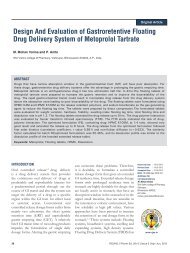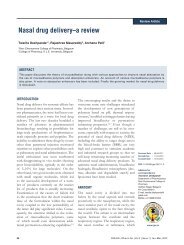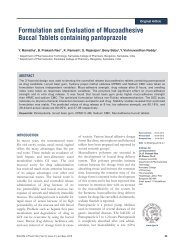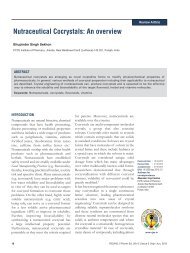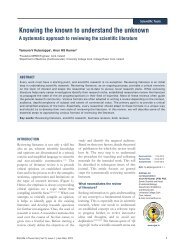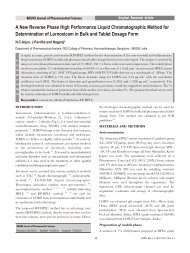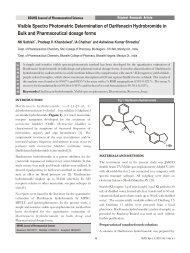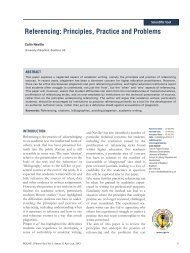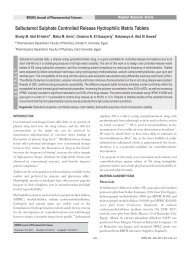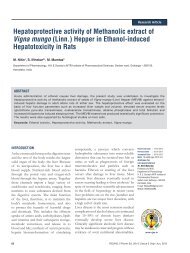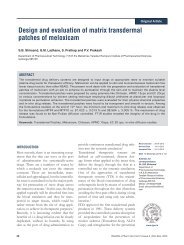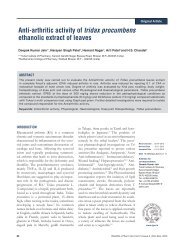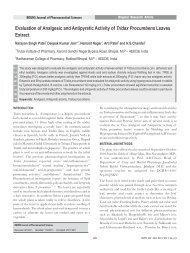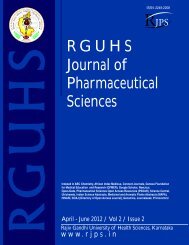Chitosan Loaded Mucoadhesive Microspheres of Gliclazide - Journal
Chitosan Loaded Mucoadhesive Microspheres of Gliclazide - Journal
Chitosan Loaded Mucoadhesive Microspheres of Gliclazide - Journal
You also want an ePaper? Increase the reach of your titles
YUMPU automatically turns print PDFs into web optimized ePapers that Google loves.
Mahendra Kumar B.J et al./ Assessment <strong>of</strong> Safety and Efficacy <strong>of</strong> Doxycycline and Azithromycin Preparations in Patients with Acne Vulgaris<br />
Table 2 : Age <strong>of</strong> onset<br />
No <strong>of</strong> cases<br />
Age group Males Females Total Percentage<br />
(years)<br />
11-15 06 06 12 22.64%<br />
16-20 18 17 35 66.03%<br />
21-25 05 01 06 11.32%<br />
Table 3: Occupation<br />
Occupation No. <strong>of</strong> patients Percentage<br />
Students 40 75.47%<br />
Lecturer 02 03.71%<br />
Librarian 01 01.88%<br />
Labourer 01 01.88%<br />
Housewife 01 01.88%<br />
Worker 06 11.32%<br />
Watchman 01 01.88%<br />
back. 3 patients (5.66%) had lesions on face and chest only.<br />
Other 7 patients (13.20%) had lesions on all the four sites<br />
(Table 4).<br />
All patients were arbitrarily divided into four grades <strong>of</strong> acne<br />
on the basis <strong>of</strong> severity. Zero patients (0.00%) belonged to<br />
grade I acne. Majority <strong>of</strong> patients 24 (45.28%) had grade II<br />
acne. Grade III and IV acne were severe types <strong>of</strong> acne<br />
consisting <strong>of</strong> cyst on nodules. 24 (45.28%) and 10 (18.86%)<br />
belonged to grade III and IV respectively. Among these 24<br />
cases <strong>of</strong> severe acne, 15 were males and 9 were females (Table<br />
5).<br />
About 41 patients gave a history <strong>of</strong> manual picking among<br />
these, 22 were males and 19 were females. Rest <strong>of</strong> the patients<br />
did not give any history <strong>of</strong> manual picking <strong>of</strong> their lesions<br />
(Table 6).<br />
Majority <strong>of</strong> the patients (35.84%) gave a history <strong>of</strong> using<br />
greasy moisturizing creams. 13.20% <strong>of</strong> patients gave a history<br />
<strong>of</strong> using talcum powder daily, 11.32% used sandalwood paste,<br />
7.54% used turmeric powder and 1 patient had used pudnia<br />
leave (Table 7).<br />
Skin type: 42 (79.24%) <strong>of</strong> the patients described their skin<br />
type as oily. 7 (13.20%) <strong>of</strong> patients called it dry. Rest <strong>of</strong> them<br />
could describe their skin type neither as oily nor as dry.<br />
Efficacy assessment <strong>of</strong> group I and group II: Twenty five<br />
patients completed study in group I, who were on treatment<br />
with azithromycin and topical clindamycin. The baseline<br />
score was 113.36 and the mean severity index declined to<br />
91.08, 62.16 and 9.92 along with the first, second and third<br />
follow-ups after the treatment <strong>of</strong> 30, 60 and 90 days. Decrease<br />
percentage was 19.65% in first follow-up, 45.17% and<br />
91.25% in the second and third follow-ups respectively.<br />
133<br />
Table 4: Distribution <strong>of</strong> Lesions<br />
Site No. <strong>of</strong> patients Percentage<br />
Face only 25 47.16%<br />
Face and back 08 15.09%<br />
Face and chest 03 05.66%<br />
Face, chest and back 10 18.86%<br />
Face, chest and back arms 07 13.20%<br />
Table 5: Severity <strong>of</strong> Acne<br />
Grade No. <strong>of</strong> patients Percentage<br />
I 00 00%<br />
II 19 35.84%<br />
III 24 45.28%<br />
IV 10 18.86%<br />
Table 6: History <strong>of</strong> Manual Picking<br />
History No. <strong>of</strong> patients Percentage<br />
Present 41 77.35%<br />
Absent 12 22.64%<br />
Table 7: Type <strong>of</strong> Cosmetics and Topical Applications used<br />
Types <strong>of</strong> application No. <strong>of</strong> patients Percentage<br />
Greasy creams 19 35.845<br />
Sandalwood paste 6 11.325<br />
Turmeric 4 7.545<br />
Pudina leaves 1 1.88%<br />
Talcum powder 7 13.20%<br />
Twenty five patients completed study in group II, who were on<br />
treatment with doxycycline and topical clindamycin. The<br />
baseline score was 107.32 and the mean severity index<br />
declined to 91.44, 66.32 and 28.00 along with the first, second<br />
and third follow-ups after the treatment <strong>of</strong> 30, 60 and 90 days.<br />
Decrease percentage was 14.80% in first follow-up, 38.20%<br />
and 73.91% in the second and third follow-ups respectively<br />
(Table 8).<br />
The severity reduction was compared with both drugs and it<br />
was tested with t-test for difference between the means; this<br />
also showed significant change in the reduction <strong>of</strong> lesions.<br />
The mean severity index <strong>of</strong> the two drugs was 113.36+19.727<br />
for azithromycin and 107.32+16.790 for doxycycline. After<br />
treatment the mean score reduced to 9.92+5.45 and<br />
28+8.377 respectively. There was a significant difference<br />
between the severity reduction when comparing the effects <strong>of</strong><br />
azithromycin and doxycycline (p



